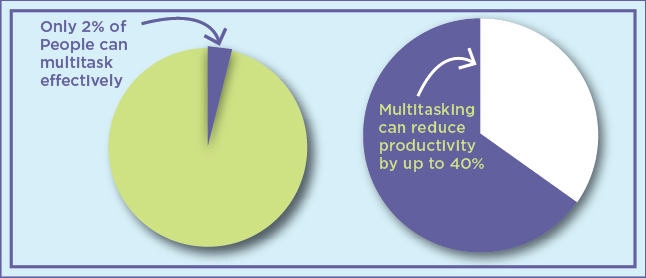Multitasking and Productivity
Do you feel multitasking is necessary when you have so much to do? While it may seem like a good way to get much more done, research shows that we are not very good at multitasking. Some researchers even suggest that doing more than one thing at a time can reduce productivity by as much as 40 percent. Yes, 40%! This is because our brains switch rapidly between tasks instead of doing two or more things simultaneously.
So, if you’re looking to boost your productivity and attention, here are some ideas to consider to reduce the level of your multitasking.
Want more tips to live a healthier and happier life? Check out the Levelhead for Real Life App here.
First, if you can’t do one thing at a time, limit it to just two. And ensure that the task you choose has low consequences if you perform less productively. For example, folding clothes while catching up with a friend on the phone or texting might be ok. However, texting and driving have very high consequences, and no one should try to do that.
Another idea is to establish the 20-minute rule. Instead of switching from one task to another in rapid succession, fully dedicate your attention to one task for 20 minutes and then switch to the other. For example, spend 20 minutes writing a report and then spend 20 minutes answering emails.
Another way to reduce the temptation to multitask is to remove the temptation from your sight, like putting your phone out of sight when you have an important conversation.
If the need to do more than one thing at a time comes from feeling like you have too much to do, try making a list and then prioritizing it. Once you’ve done this, you can plan when you will complete each task and how much time you need to complete it. You might find that it takes a lot less time when your attention is focused.
Rewarding yourself for maintaining your focus is also a good technique to help change your behavior. For example, if you commit to staying focused on one task, reward yourself with a short social media break. But be careful with this. You might spend more time on it than you think. So, consider limits.
And finally, declutter your workspace. A distraction-free environment can help you stay focused by removing items that remind you of everything you must do.
Before you move on from this blog, consider a time you’d like to focus on one task at a time. Just know that breaking the habit of multi-tasking is not easy. Start slowly by setting reasonable goals. And try not to judge yourself. Learning to focus your attention is a skill, and like all skills, you will improve with practice.
NEXT WEEK: Have you ever been impressed when someone you met just one time remembers your name? In next week's blog Saundra discusses how mindfulness practice can help you with remembering names.


